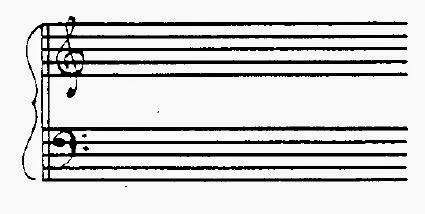The notes are placed on this staff and they represent relative highness or lowness of pitches.
Each of the lines represents a note name. The note names are
always arranged in an alphabetical order as given: A B C D E F G (This is in a
cyclic manner of course). The positions of the notes are decided by the clef that
is present at the beginning of the staff. There are three types of clef. The
‘F’ clef, the ‘G’ clef and the ‘C’ clef. The F clef is also known as the bass
clef and it fixes the position of the F note on the staff. After that we can
follow the order of notes to know the position of other notes. Similarly the G
clef also known as the treble clef fixes the position of G note on the staff
and the C clef fixes the position of C note on the staff. The following images
will clarify everything.
The F clef
The G clef
G and the F clef shown together
The C clef
When the bass clef and the treble clef are combined together
we get the staff known as the grand staff or the great staff. Below is an
example image of a grand staff.
The grand staff
Now what if we want to write notes which have higher or
lower pitches than the staff can contain? In that case we draw extra small
horizontal lines above or below the staff lines as the requirement may be.
Below is an example image for the same. These extra lines are called leger lines.
Notice that if you want to add a note which is directly
above a staff line or leger line, you do not require additional line to place
that note.
Now you may be thinking that there are twelve notes in total
and the staff shows only the natural notes. What about the accidental notes?
How to place them on the staff? Well there is a very simple way to do this. A
sharp (#) or a flat (b) is added just before the note to make it sharp or flat
respectively. But when we write‘#’ or a ‘b’ on any staff line, it continues to
affect all the notes ahead placed on that line. So what if we want a C note
after a C#? We must know how to cancel the effect of this sharp. For this we
have a special symbol which is called natural. The following image will clear
everything.
When we need to make a note raise or lower by two half
steps, we need to add a double flat or double sharp.
A double flatted note
One more thing that you must notice is that we have five different kind of accidentals. They are
double flat, flat, natural, sharp and double sharp.
Well there are certain rules regarding the accidentals as
far as the staff is concerned. They are as follows:
A natural will cancel the effect of a flat or sharp or a
double flat or double sharp.
Similarly, a single sharp or flat will cancel the effect of
a double sharp or double flat respectively.
To raise a note which has already been sharpened or flatted,
you need to use a double sharp or double flat respectively.
Accidental only affects the specific note in that octave in
that clef.
Now let me tell you how to easily know the key just by
looking at the staff. You may notice that just after the clef, various sharps
or flats are added in a SPECIFIC ORDER. If it is in flat key, the key will be
represented by the second last flat on the staff. If it is in a sharp key, the
key will be represented by the note half step above the last sharp. Refer to
the images for better understanding.
Unlike the rules for accidentals, key signatures will affect
all the notes of the same name regardless of their octave.














No comments:
Post a Comment